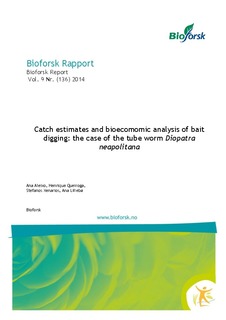| dc.description.abstract | There has been an extensive review on the environmental and commercial significance of fishery species in European coastal lagoons in addition to a representative indexing of fishing fauna. However, the economic effects of fishery and particularly bait digging to the local economy are scarce while the impacts of the activity to the stock reserves of different baits are poorly explored. To this end, the current study has estimated the digging effort and rate of the species Diopatra neapolitana, which is captured through a bait digging activity. The study area was located in Ria de Aveiro coastal lagoon at northwest Atlantic coast of Portugal, which is a mesotidal lagoon with extensive intertidal mud and sand flat areas exposed during low tide. Different management scenarios of openaccess, maximum sustainable yield (MSY) and maximum economic yield (MEY) were explored through a bioeconomic analysis. The results show that in the southern parts of the lagoon, the digging effort is higher along spring tides except autumn season while the annual catch was estimated at 9,000kg yr−1. In the northern parts the lack of sufficient data prohibited seasonal analysis. However, the annual catch was estimated to probably exceed 36,000kg yr−1 . The bioeconomic results have shown that the open access scenario can provoke a gradual depletion of Diopatra neapolitana reserves if only the diggers will conduct digging activity two times within a day. The maximum sustainable yield scenario (MSY) has shown that the digging activity has not reached the maximum allowed effort if only the daytime activity is taken into account. The maximum economic yield (MEY) scenario however indicated that the diggers may be currently close to maximum catch by considering only the daytime workout. The current economic benefits of bait digging may encourage new bait catchers to practice this activity given the low profitability in other similar employment sectors. The results should be further clarified through the introduction of biological production modeling as well spatial and temporal dynamic analysis. | nb_NO |
